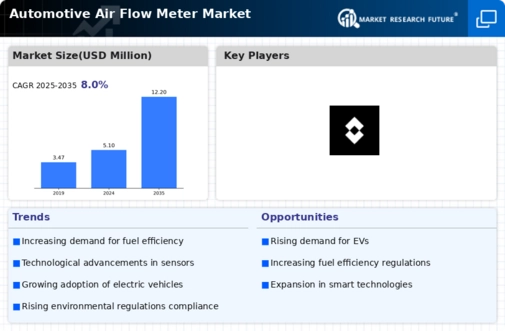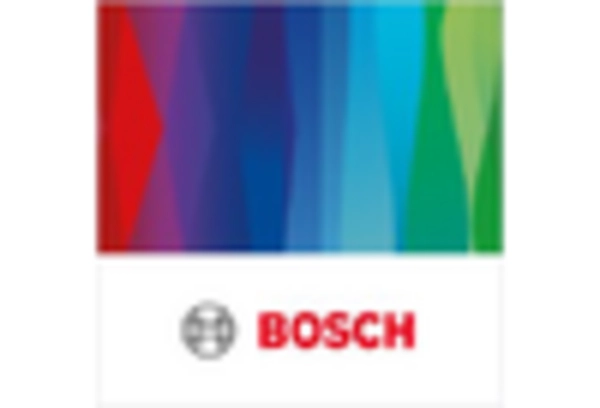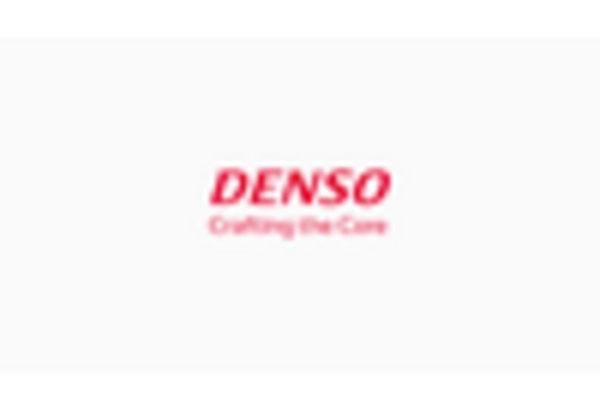-
Global Automotive Air Flow Meter Market, by Sales Channel
-
Global
-
Automotive Air Flow Meter Market, by Display Type
-
Global Automotive
-
Air Flow Meter Market, by Region
-
Market Introduction
-
Definition
-
Scope
-
of the Study
-
Market Structure
-
Research
-
Methodology
-
Research Process
-
Primary Research
-
Secondary
-
Research
-
Market Size Estimation
-
Forecast Model
-
List
-
of Assumptions
-
Market Dynamics
-
Introduction
-
Drivers
-
Rising
-
automotive sector, with its increased demand for precision and robustness of airflow
-
Driver
-
Driver 3
-
Drivers Impact Analysis
-
Restraints
-
sales
-
of components utilized in ICE vehicles are being hampered by the steady rise in
-
demand for electric vehicles
-
Rising labor costs are causing Automotive
-
Air Flow Meter's profit margins to shrink
-
Restraints Impact Analysis
-
Opportunities
-
Electric
-
vehicle market penetration has been witnessed across the globe by the automotive
-
sector
-
Opportunity 2
-
Challenge
-
Challenge
-
Impact of COVID-19
-
Impact on Automotive
-
Air Flow Meter market
-
Impact on YoY Growth
-
Market Factor Analysis
-
Value
-
Chain Analysis/Supply Chain Analysis
-
Porter’s Five Forces Model
-
Bargaining
-
Power of Suppliers
-
Bargaining Power of Buyers
-
Threat of
-
New Entrants
-
Threat of Substitutes
-
Intensity of Rivalry
-
Market
-
SWOT analysis
-
Market PESTEL analysis
-
Global
-
Automotive Air Flow Meter Market Size Estimation & Forecast, by Vehicle Type
-
Introduction
-
Heavy
-
Duty Vehicle
-
Light Duty Vehicle
-
Global
-
Automotive Air Flow Meter Market Size Estimation & Forecast, by Sales
-
Channel
-
Introduction
-
Aftersales Market
-
Original
-
Equipment Market (OEM)
-
Global Automotive Air
-
Flow Meter Market Size Estimation & Forecast, by DISPLAY TYPE
-
Introduction
-
Analog
-
Type
-
Digital Type
-
Global Automotive
-
Air Flow Meter Market Size Estimation & Forecast, by Region
-
Introduction
-
North
-
America
-
Market Estimates & Forecast, by Region, 2022-2030
-
Market
-
Estimates & Forecast, by Vehicle Type, 2022-2030
-
Market Estimates
-
& Forecast, by Sales Channel, 2022-2030
-
Market Estimates & Forecast,
-
by Display Type, 2022-2030
-
US
-
Market Estimates &
-
Forecast, by Vehicle Type, 2022-2030
-
Market
-
Estimates & Forecast, by Sales Channel, 2022-2030
-
Market
-
Estimates & Forecast, by Display Type, 2022-2030
-
Canada
-
Market
-
Estimates & Forecast, by Vehicle Type, 2022-2030
-
Market
-
Estimates & Forecast, by Sales Channel, 2022-2030
-
Market
-
Estimates & Forecast, by Display Type, 2022-2030
-
Mexico
-
Market
-
Estimates & Forecast, by Vehicle Type, 2022-2030
-
Market
-
Estimates & Forecast, by Sales Channel, 2022-2030
-
Market
-
Estimates & Forecast, by Display Type, 2022-2030
-
Europe
-
Market
-
Estimates & Forecast, by Region, 2022-2030
-
Market Estimates &
-
Forecast, by Vehicle Type, 2022-2030
-
Market Estimates & Forecast,
-
by Sales Channel, 2022-2030
-
Market Estimates & Forecast, by Display
-
Type, 2022-2030
-
UK
-
Market Estimates & Forecast,
-
by Vehicle Type, 2022-2030
-
Market
-
Estimates & Forecast, by Sales Channel, 2022-2030
-
Market
-
Estimates & Forecast, by Display Type, 2022-2030
-
Germany
-
Market
-
Estimates & Forecast, by Vehicle Type, 2022-2030
-
Market
-
Estimates & Forecast, by Sales Channel, 2022-2030
-
Market
-
Estimates & Forecast, by Display Type, 2022-2030
-
France
-
Market
-
Estimates & Forecast, by Vehicle Type, 2022-2030
-
Market
-
Estimates & Forecast, by Sales Channel, 2022-2030
-
Market
-
Estimates & Forecast, by Display Type, 2022-2030
-
Rest
-
of Europe
-
Market Estimates & Forecast, by Vehicle Type, 2022-2030
-
Market
-
Estimates & Forecast, by Sales Channel, 2022-2030
-
Market
-
Estimates & Forecast, by Display Type, 2022-2030
-
Asia-Pacific
-
Market
-
Estimates & Forecast, by Region, 2022-2030
-
Market Estimates &
-
Forecast, by Vehicle Type, 2022-2030
-
Market Estimates & Forecast,
-
by Sales Channel, 2022-2030
-
Market Estimates & Forecast, by Display
-
Type, 2022-2030
-
China
-
Market Estimates & Forecast,
-
by Vehicle Type, 2022-2030
-
Market
-
Estimates & Forecast, by Sales Channel, 2022-2030
-
Market
-
Estimates & Forecast, by Display Type, 2022-2030
-
India
-
Market
-
Estimates & Forecast, by Vehicle Type, 2022-2030
-
Market
-
Estimates & Forecast, by Sales Channel, 2022-2030
-
Market
-
Estimates & Forecast, by Display Type, 2022-2030
-
Japan
-
Market
-
Estimates & Forecast, by Vehicle Type, 2022-2030
-
Market
-
Estimates & Forecast, by Sales Channel, 2022-2030
-
Market
-
Estimates & Forecast, by Display Type, 2022-2030
-
Rest
-
of Asia-Pacific
-
Market Estimates & Forecast, by Vehicle Type,
-
Market Estimates &
-
Forecast, by Sales Channel, 2022-2030
-
Market
-
Estimates & Forecast, by Display Type, 2022-2030
-
Rest
-
of the World
-
Market Estimates & Forecast, by Region, 2022-2030
-
Market
-
Estimates & Forecast, by Vehicle Type, 2022-2030
-
Market Estimates
-
& Forecast, by Sales Channel, 2022-2030
-
Market Estimates & Forecast,
-
by Display Type, 2022-2030
-
Middle East & Africa
-
Market
-
Estimates & Forecast, by Vehicle Type, 2022-2030
-
Market
-
Estimates & Forecast, by Sales Channel, 2022-2030
-
Market
-
Estimates & Forecast, by Display Type, 2022-2030
-
South
-
America
-
Market Estimates & Forecast, by Vehicle Type, 2022-2030
-
Market
-
Estimates & Forecast, by Sales Channel, 2022-2030
-
Market
-
Estimates & Forecast, by Display Type, 2022-2030
-
Competitive Landscape
-
Introduction
-
Key
-
Players Market Share Analysis, 2022 (%)
-
Competitive Benchmarking
-
Key Developments & Growth Strategies
-
New Product Development/Product Innovation
-
Mergers & Acquisitions
-
Contracts & Agreements
-
Expansions
-
& Investments
-
Company
-
Profiles
-
DENSO Corporation
-
Company Overview
-
Financial
-
Overview
-
Products Offered
-
Key Developments
-
SWOT
-
Analysis
-
Key Strategies
-
Robert Bosch GmbH
-
Festo
-
AG & Co. KG
-
Hitachi, Ltd
-
Delphi Automotive PLC
-
ACDelco
-
Mitsubishi
-
Motors Corporation
-
K&N Engineering, Inc
-
Nissan Motor
-
Co., Ltd.
-
FLIR Systems
-
Company 11
-
Company 12
-
Company
-
Company 14
-
Company 15
-
Other Players
-
LIST
-
OF TABLES
-
LIST OF ASSUMPTIONS 31
-
GLOBAL
-
AUTOMOTIVE AIR FLOW METER, BY VEHICLE TYPE, 2022–2030 (USD MILLION) 46
-
TABLE
-
GLOBAL AUTOMOTIVE AIR FLOW METER, BY SALES CHANNEL, 2022–2030 (USD
-
MILLION) 49
-
GLOBAL AUTOMOTIVE AIR FLOW METER, BY DISPLAY TYPE,
-
GLOBAL AUTOMOTIVE AIR FLOW
-
METER, BY REGION, 2022–2030 (USD MILLION) 53
-
NORTH
-
AMERICA: AUTOMOTIVE AIR FLOW METER MARKET, BY COUNTRY, 2022–2030 (USD
-
MILLION) 55
-
NORTH AMERICA: AUTOMOTIVE AIR FLOW METER MARKET, BY
-
VEHICLE TYPE, 2022–2030 (USD MILLION) 57
-
NORTH AMERICA:
-
AUTOMOTIVE AIR FLOW METER MARKET, BY SALES CHANNEL, 2022–2030 (USD MILLION)
-
NORTH AMERICA: AUTOMOTIVE AIR FLOW METER MARKET, BY DISPLAY
-
TYPE, 2022–2030 (USD MILLION) 61
-
US: AUTOMOTIVE AIR
-
FLOW METER MARKET, BY VEHICLE TYPE, 2022–2030 (USD MILLION) 63
-
TABLE
-
US: AUTOMOTIVE AIR FLOW METER MARKET, BY SALES CHANNEL, 2022–2030 (USD
-
MILLION) 65
-
US: AUTOMOTIVE AIR FLOW METER MARKET, BY DISPLAY
-
TYPE, 2022–2030 (USD MILLION) 67
-
CANADA: AUTOMOTIVE
-
AIR FLOW METER MARKET, BY VEHICLE TYPE, 2022–2030 (USD MILLION) 69
-
TABLE
-
CANADA: AUTOMOTIVE AIR FLOW METER MARKET, BY SALES CHANNEL, 2022–2030 (USD
-
MILLION) 71
-
CANADA: AUTOMOTIVE AIR FLOW METER MARKET, BY DISPLAY
-
TYPE, 2022–2030 (USD MILLION) 73
-
MEXICO: AUTOMOTIVE
-
AIR FLOW METER MARKET, BY VEHICLE TYPE, 2022–2030 (USD MILLION) 75
-
TABLE
-
MEXICO: AUTOMOTIVE AIR FLOW METER MARKET, BY SALES CHANNEL, 2022–2030 (USD
-
MILLION) 77
-
MEXICO: AUTOMOTIVE AIR FLOW METER MARKET, BY DISPLAY
-
TYPE, 2022–2030 (USD MILLION) 79
-
EUROPE: AUTOMOTIVE
-
AIR FLOW METER MARKET, BY COUNTRY, 2022–2030 (USD MILLION) 81
-
TABLE
-
EUROPE: AUTOMOTIVE AIR FLOW METER MARKET, BY VEHICLE TYPE, 2022–2030 (USD
-
MILLION) 83
-
EUROPE: AUTOMOTIVE AIR FLOW METER MARKET, BY SALES
-
CHANNEL, 2022–2030 (USD MILLION) 85
-
EUROPE: AUTOMOTIVE
-
AIR FLOW METER MARKET, BY DISPLAY TYPE, 2022–2030 (USD MILLION) 87
-
TABLE
-
UK: AUTOMOTIVE AIR FLOW METER MARKET, BY VEHICLE TYPE, 2022–2030 (USD
-
MILLION) 89
-
UK: AUTOMOTIVE AIR FLOW METER MARKET, BY SALES CHANNEL,
-
UK: AUTOMOTIVE AIR FLOW
-
METER MARKET, BY DISPLAY TYPE, 2022–2030 (USD MILLION) 93
-
TABLE
-
GERMANY: AUTOMOTIVE AIR FLOW METER MARKET, BY VEHICLE TYPE, 2022–2030 (USD
-
MILLION) 95
-
GERMANY: AUTOMOTIVE AIR FLOW METER MARKET, BY SALES
-
CHANNEL, 2022–2030 (USD MILLION) 97
-
GERMANY: AUTOMOTIVE
-
AIR FLOW METER MARKET, BY DISPLAY TYPE, 2022–2030 (USD MILLION) 99
-
TABLE
-
FRANCE: AUTOMOTIVE AIR FLOW METER MARKET, BY VEHICLE TYPE, 2022–2030 (USD
-
MILLION) 101
-
FRANCE: AUTOMOTIVE AIR FLOW METER MARKET, BY SALES
-
CHANNEL, 2022–2030 (USD MILLION) 103
-
FRANCE: AUTOMOTIVE
-
AIR FLOW METER MARKET, BY DISPLAY TYPE, 2022–2030 (USD MILLION) 105
-
TABLE
-
ITALY: AUTOMOTIVE AIR FLOW METER MARKET, BY VEHICLE TYPE, 2022–2030 (USD
-
MILLION) 107
-
ITALY: AUTOMOTIVE AIR FLOW METER MARKET, BY SALES
-
CHANNEL, 2022–2030 (USD MILLION) 109
-
ITALY: AUTOMOTIVE
-
AIR FLOW METER MARKET, BY DISPLAY TYPE, 2022–2030 (USD MILLION) 111
-
TABLE
-
SPAIN: AUTOMOTIVE AIR FLOW METER MARKET, BY VEHICLE TYPE, 2022–2030 (USD
-
MILLION) 113
-
SPAIN: AUTOMOTIVE AIR FLOW METER MARKET, BY SALES
-
CHANNEL, 2022–2030 (USD MILLION) 115
-
SPAIN: AUTOMOTIVE
-
AIR FLOW METER MARKET, BY DISPLAY TYPE, 2022–2030 (USD MILLION) 117
-
TABLE
-
REST OF EUROPE: AUTOMOTIVE AIR FLOW METER MARKET, BY VEHICLE TYPE, 2022–2030 (USD
-
MILLION) 119
-
REST OF EUROPE: AUTOMOTIVE AIR FLOW METER MARKET,
-
BY SALES CHANNEL, 2022–2030 (USD MILLION) 121
-
REST
-
OF EUROPE: AUTOMOTIVE AIR FLOW METER MARKET, BY DISPLAY TYPE, 2022–2030 (USD
-
MILLION) 123
-
ASIA-PACIFIC: AUTOMOTIVE AIR FLOW METER MARKET,
-
BY COUNTRY, 2022–2030 (USD MILLION) 125
-
ASIA-PACIFIC:
-
AUTOMOTIVE AIR FLOW METER MARKET, BY VEHICLE TYPE, 2022–2030 (USD MILLION)
-
ASIA-PACIFIC: AUTOMOTIVE AIR FLOW METER MARKET, BY SALES
-
CHANNEL, 2022–2030 (USD MILLION) 129
-
ASIA-PACIFIC:
-
AUTOMOTIVE AIR FLOW METER MARKET, BY DISPLAY TYPE, 2022–2030 (USD MILLION)
-
CHINA: AUTOMOTIVE AIR FLOW METER MARKET, BY VEHICLE TYPE,
-
CHINA: AUTOMOTIVE AIR
-
FLOW METER MARKET, BY SALES CHANNEL, 2022–2030 (USD MILLION) 135
-
TABLE
-
CHINA: AUTOMOTIVE AIR FLOW METER MARKET, BY DISPLAY TYPE, 2022–2030 (USD
-
MILLION) 137
-
INDIA: AUTOMOTIVE AIR FLOW METER MARKET, BY VEHICLE
-
TYPE, 2022–2030 (USD MILLION) 139
-
INDIA: AUTOMOTIVE
-
AIR FLOW METER MARKET, BY SALES CHANNEL, 2022–2030 (USD MILLION) 141
-
TABLE
-
INDIA: AUTOMOTIVE AIR FLOW METER MARKET, BY DISPLAY TYPE, 2022–2030 (USD
-
MILLION) 143
-
JAPAN: AUTOMOTIVE AIR FLOW METER MARKET, BY VEHICLE
-
TYPE, 2022–2030 (USD MILLION) 145
-
JAPAN: AUTOMOTIVE
-
AIR FLOW METER MARKET, BY SALES CHANNEL, 2022–2030 (USD MILLION) 147
-
TABLE
-
JAPAN: AUTOMOTIVE AIR FLOW METER MARKET, BY DISPLAY TYPE, 2022–2030 (USD
-
MILLION) 149
-
SOUTH KOREA: AUTOMOTIVE AIR FLOW METER MARKET, BY
-
VEHICLE TYPE, 2022–2030 (USD MILLION) 151
-
SOUTH KOREA:
-
AUTOMOTIVE AIR FLOW METER MARKET, BY SALES CHANNEL, 2022–2030 (USD MILLION)
-
SOUTH KOREA: AUTOMOTIVE AIR FLOW METER MARKET, BY DISPLAY
-
TYPE, 2022–2030 (USD MILLION) 155
-
REST OF ASIA-PACIFIC:
-
AUTOMOTIVE AIR FLOW METER MARKET, BY VEHICLE TYPE, 2022–2030 (USD MILLION)
-
REST OF ASIA-PACIFIC: AUTOMOTIVE AIR FLOW METER MARKET, BY
-
SALES CHANNEL, 2022–2030 (USD MILLION) 159
-
REST OF
-
ASIA-PACIFIC: AUTOMOTIVE AIR FLOW METER MARKET, BY DISPLAY TYPE, 2022–2030 (USD
-
MILLION) 161
-
MIDDLE EAST & AFRICA: AUTOMOTIVE AIR FLOW METER
-
MARKET, BY COUNTRY, 2022–2030 (USD MILLION) 163
-
MIDDLE
-
EAST & AFRICA: AUTOMOTIVE AIR FLOW METER MARKET, BY VEHICLE TYPE, 2022–2030 (USD
-
MILLION) 165
-
MIDDLE EAST & AFRICA: AUTOMOTIVE AIR FLOW METER
-
MARKET, BY SALES CHANNEL, 2022–2030 (USD MILLION) 167
-
TABLE
-
MIDDLE EAST & AFRICA: AUTOMOTIVE AIR FLOW METER MARKET, BY DISPLAY TYPE,
-
UAE: AUTOMOTIVE AIR FLOW
-
METER MARKET, BY VEHICLE TYPE, 2022–2030 (USD MILLION) 171
-
TABLE
-
UAE: AUTOMOTIVE AIR FLOW METER MARKET, BY SALES CHANNEL, 2022–2030 (USD
-
MILLION) 173
-
UAE: AUTOMOTIVE AIR FLOW METER MARKET, BY DISPLAY
-
TYPE, 2022–2030 (USD MILLION) 175
-
SAUDI ARABIA: AUTOMOTIVE
-
AIR FLOW METER MARKET, BY VEHICLE TYPE, 2022–2030 (USD MILLION) 177
-
TABLE
-
SAUDI ARABIA: AUTOMOTIVE AIR FLOW METER MARKET, BY SALES CHANNEL, 2022–2030 (USD
-
MILLION) 179
-
SAUDI ARABIA: AUTOMOTIVE AIR FLOW METER MARKET,
-
BY DISPLAY TYPE, 2022–2030 (USD MILLION) 181
-
SOUTH
-
AFRICA: AUTOMOTIVE AIR FLOW METER MARKET, BY VEHICLE TYPE, 2022–2030 (USD
-
MILLION) 183
-
SOUTH AFRICA: AUTOMOTIVE AIR FLOW METER MARKET,
-
BY SALES CHANNEL, 2022–2030 (USD MILLION) 185
-
SOUTH
-
AFRICA: AUTOMOTIVE AIR FLOW METER MARKET, BY DISPLAY TYPE, 2022–2030 (USD
-
MILLION) 187
-
REST OF MEA: AUTOMOTIVE AIR FLOW METER MARKET, BY
-
VEHICLE TYPE, 2022–2030 (USD MILLION) 189
-
REST OF
-
MEA: AUTOMOTIVE AIR FLOW METER MARKET, BY SALES CHANNEL, 2022–2030 (USD
-
MILLION) 191
-
REST OF MEA: AUTOMOTIVE AIR FLOW METER MARKET, BY
-
DISPLAY TYPE, 2022–2030 (USD MILLION) 193
-
SOUTH AMERICA:
-
AUTOMOTIVE AIR FLOW METER MARKET, BY COUNTRY, 2022–2030 (USD MILLION)
-
SOUTH AMERICA: AUTOMOTIVE AIR FLOW METER MARKET, BY VEHICLE
-
TYPE, 2022–2030 (USD MILLION) 197
-
SOUTH AMERICA: AUTOMOTIVE
-
AIR FLOW METER MARKET, BY SALES CHANNEL, 2022–2030 (USD MILLION) 199
-
TABLE
-
SOUTH AMERICA: AUTOMOTIVE AIR FLOW METER MARKET, BY DISPLAY TYPE, 2022–2030 (USD
-
MILLION) 201
-
BRAZIL: AUTOMOTIVE AIR FLOW METER MARKET, BY VEHICLE
-
TYPE, 2022–2030 (USD MILLION) 203
-
BRAZIL: AUTOMOTIVE
-
AIR FLOW METER MARKET, BY SALES CHANNEL, 2022–2030 (USD MILLION) 205
-
TABLE
-
BRAZIL: AUTOMOTIVE AIR FLOW METER MARKET, BY DISPLAY TYPE, 2022–2030 (USD
-
MILLION) 207
-
ARGENTINA: AUTOMOTIVE AIR FLOW METER MARKET, BY
-
VEHICLE TYPE, 2022–2030 (USD MILLION) 209
-
ARGENTINA:
-
AUTOMOTIVE AIR FLOW METER MARKET, BY SALES CHANNEL, 2022–2030 (USD MILLION)
-
ARGENTINA: AUTOMOTIVE AIR FLOW METER MARKET, BY DISPLAY TYPE,
-
REST OF SOUTH AMERICA:
-
AUTOMOTIVE AIR FLOW METER MARKET, BY VEHICLE TYPE, 2022–2030 (USD MILLION)
-
REST OF SOUTH AMERICA: AUTOMOTIVE AIR FLOW METER MARKET,
-
BY SALES CHANNEL, 2022–2030 (USD MILLION) 217
-
REST
-
OF SOUTH AMERICA: AUTOMOTIVE AIR FLOW METER MARKET, BY DISPLAY TYPE, 2022–2030 (USD
-
MILLION) 219
-
KEY DEVELOPMENTS: CONTRACTS & AGREEMENTS 221
-
TABLE
-
KEY DEVELOPMENTS: PARTNERSHIPS & COLLABORATIONS 223
-
KEY
-
DEVELOPMENTS: PRODUCT DEVELOPMENTS/LAUNCHES 225
-
DENSO CORPORATION :
-
PRODUCTS OFFERED 227
-
DENSO CORPORATION : KEY DEVELOPMENTS
-
ROBERT BOSCH GMBH: PRODUCTS OFFERED 231
-
TABLE 95
-
ROBERT BOSCH GMBH: KEY DEVELOPMENTS 233
-
FESTO AG & CO. KG:
-
PRODUCTS OFFERED 235
-
FESTO AG & CO. KG: KEY DEVELOPMENTS
-
HITACHI, LTD: PRODUCTS OFFERED 239
-
HITACHI,
-
LTD: KEY DEVELOPMENTS 241
-
DELPHI AUTOMOTIVE PLC: PRODUCTS OFFERED
-
DELPHI AUTOMOTIVE PLC: KEY DEVELOPMENTS 245
-
TABLE
-
ACDELCO: PRODUCTS OFFERED 247
-
ACDELCO: KEY DEVELOPMENTS
-
MITSUBISHI MOTORS CORPORATION: PRODUCTS OFFERED 251
-
TABLE
-
MITSUBISHI MOTORS CORPORATION: KEY DEVELOPMENTS 253
-
K&N
-
ENGINEERING, INC: PRODUCTS OFFERED 255
-
K&N ENGINEERING,
-
INC: KEY DEVELOPMENTS 257
-
NISSAN MOTOR CO., LTD.: PRODUCTS OFFERED
-
NISSAN MOTOR CO., LTD.: KEY DEVELOPMENTS 261
-
TABLE
-
FLIR SYSTEMS: PRODUCTS OFFERED 263
-
FLIR SYSTEMS: KEY DEVELOPMENTS
-
COMPANY 11: PRODUCTS OFFERED 267
-
COMPANY
-
11: KEY DEVELOPMENTS 269
-
COMPANY 12: PRODUCTS OFFERED 271
-
TABLE
-
COMPANY 12: KEY DEVELOPMENTS 273
-
COMPANY 13: PRODUCTS OFFERED
-
COMPANY 13: KEY DEVELOPMENTS 277
-
COMPANY
-
14: PRODUCTS OFFERED 279
-
COMPANY 14: KEY DEVELOPMENTS 281
-
TABLE
-
COMPANY 15: PRODUCTS OFFERED 283
-
COMPANY 15: PRODUCTS OFFERED
-
LIST OF FIGURES
-
FIGURE
-
MARKET SYNOPSIS 20
-
GLOBAL AUTOMOTIVE AIR FLOW METER, BY VEHICLE
-
TYPE, 2022–2030 (USD MILLION) 21
-
GLOBAL AUTOMOTIVE
-
AIR FLOW METER MARKET ANALYSIS, BY SALES CHANNEL 22
-
GLOBAL AUTOMOTIVE
-
AIR FLOW METER MARKET ANALYSIS, BY DISPLAY TYPE 23
-
GLOBAL AUTOMOTIVE
-
AIR FLOW METER MARKET: STRUCTURE 25
-
RESEARCH PROCESS 26
-
FIGURE
-
TOP-DOWN & BOTTOM-UP APPROACHES 27
-
MARKET DYNAMICS OVERVIEW
-
DRIVER IMPACT ANALYSIS: GLOBAL AUTOMOTIVE AIR FLOW METER MARKET
-
RESTRAINT IMPACT ANALYSIS: GLOBAL AUTOMOTIVE AIR FLOW METER
-
MARKET 30
-
PORTER’S FIVE FORCES ANALYSIS: GLOBAL AUTOMOTIVE
-
AIR FLOW METER 31
-
SUPPLY CHAIN ANALYSIS: GLOBAL AUTOMOTIVE AIR
-
FLOW METER 32
-
GLOBAL AUTOMOTIVE AIR FLOW METER, BY VEHICLE TYPE,
-
GLOBAL AUTOMOTIVE AIR FLOW METER, BY VEHICLE
-
TYPE, 2022–2030 (USD MILLION) 34
-
GLOBAL AUTOMOTIVE
-
AIR FLOW METER, BY SALES CHANNEL, 2022 (% SHARE) 35
-
GLOBAL AUTOMOTIVE
-
AIR FLOW METER, BY SALES CHANNEL, 2022–2030 (USD MILLION) 36
-
FIGURE
-
GLOBAL AUTOMOTIVE AIR FLOW METER, BY DISPLAY TYPE, 2022 (% SHARE) 37
-
FIGURE
-
GLOBAL AUTOMOTIVE AIR FLOW METER, BY DISPLAY TYPE, 2022–2030 (USD
-
MILLION) 38
-
GLOBAL AUTOMOTIVE AIR FLOW METER, BY REGION, 2022 TO
-
GLOBAL AUTOMOTIVE AIR FLOW METER,
-
BY REGION, 2022 (% SHARE) 42
-
NORTH AMERICA: AUTOMOTIVE AIR FLOW
-
METER MARKET SHARE, BY COUNTRY, 2022 (% SHARE) 43
-
EUROPE: AUTOMOTIVE
-
AIR FLOW METER MARKET SHARE, BY COUNTRY, 2022 (% SHARE) 44
-
ASIA-PACIFIC:
-
AUTOMOTIVE AIR FLOW METER MARKET SHARE, BY COUNTRY, 2022 (% SHARE) 45
-
FIGURE
-
MIDDLE EAST & AFRICA: AUTOMOTIVE AIR FLOW METER MARKET SHARE, BY COUNTRY,
-
SOUTH AMERICA: AUTOMOTIVE AIR FLOW METER MARKET
-
SHARE, BY COUNTRY, 2022 (% SHARE) 47
-
BENCHMARKING OF MAJOR COMPETITORS
-
GLOBAL AUTOMOTIVE AIR FLOW METER MARKET SHARE ANALYSIS, 2022
-
DENSO CORPORATION : FINANCIAL OVERVIEW SNAPSHOT 50
-
FIGURE
-
DENSO CORPORATION : SWOT ANALYSIS 51
-
ROBERT BOSCH GMBH:
-
FINANCIAL OVERVIEW SNAPSHOT 52
-
ROBERT BOSCH GMBH: SWOT ANALYSIS
-
FESTO AG & CO. KG: FINANCIAL OVERVIEW SNAPSHOT 54
-
FIGURE
-
FESTO AG & CO. KG: SWOT ANALYSIS 55
-
HITACHI, LTD: FINANCIAL
-
OVERVIEW SNAPSHOT 56
-
HITACHI, LTD: SWOT ANALYSIS 57
-
FIGURE
-
DELPHI AUTOMOTIVE PLC: FINANCIAL OVERVIEW SNAPSHOT 58
-
DELPHI
-
AUTOMOTIVE PLC: SWOT ANALYSIS 59
-
ACDELCO: FINANCIAL OVERVIEW
-
SNAPSHOT 60
-
ACDELCO: SWOT ANALYSIS 61
-
MITSUBISHI
-
MOTORS CORPORATION: FINANCIAL OVERVIEW SNAPSHOT 62
-
MITSUBISHI
-
MOTORS CORPORATION: SWOT ANALYSIS 63
-
K&N ENGINEERING, INC:
-
FINANCIAL OVERVIEW SNAPSHOT 64
-
K&N ENGINEERING, INC: SWOT
-
ANALYSIS 65
-
NISSAN MOTOR CO., LTD.: FINANCIAL OVERVIEW SNAPSHOT
-
NISSAN MOTOR CO., LTD.: SWOT ANALYSIS 67
-
FIGURE
-
FLIR SYSTEMS: FINANCIAL OVERVIEW SNAPSHOT 68
-
FLIR SYSTEMS:
-
SWOT ANALYSIS 69
-
COMPANY 11: FINANCIAL OVERVIEW SNAPSHOT 70
-
FIGURE
-
COMPANY 11: SWOT ANALYSIS 71
-
COMPANY 12: FINANCIAL OVERVIEW
-
SNAPSHOT 72
-
COMPANY 12: SWOT ANALYSIS 73
-
FIGURE 52
-
COMPANY 13: FINANCIAL OVERVIEW SNAPSHOT 74
-
COMPANY 13: SWOT
-
ANALYSIS 75
-
COMPANY 14: FINANCIAL OVERVIEW SNAPSHOT 76
-
FIGURE
-
COMPANY 14: SWOT ANALYSIS 77
-
COMPANY 15: FINANCIAL OVERVIEW
-
SNAPSHOT 78
-
COMPANY 15: FINANCIAL OVERVIEW SNAPSHOT 79

















Leave a Comment